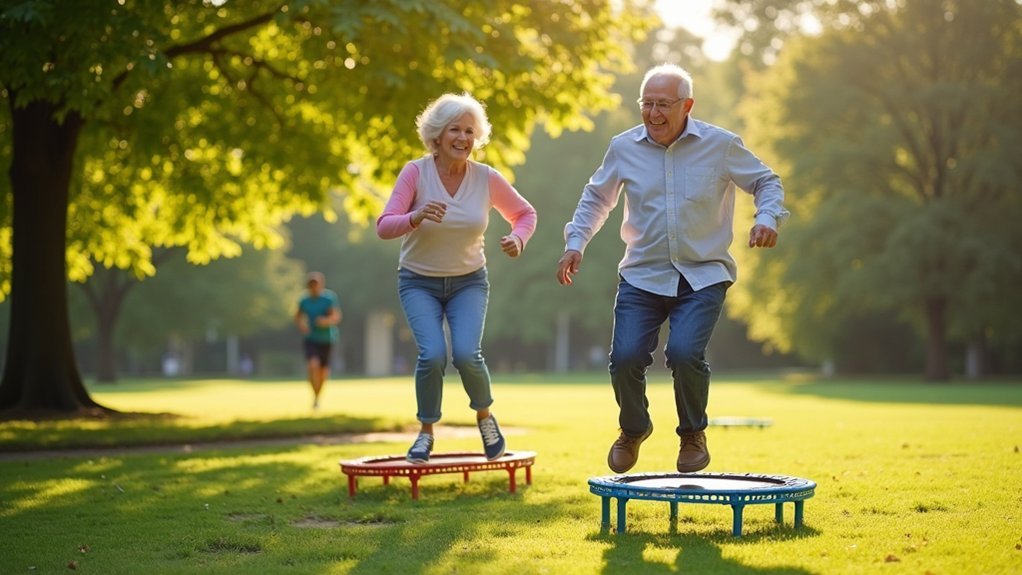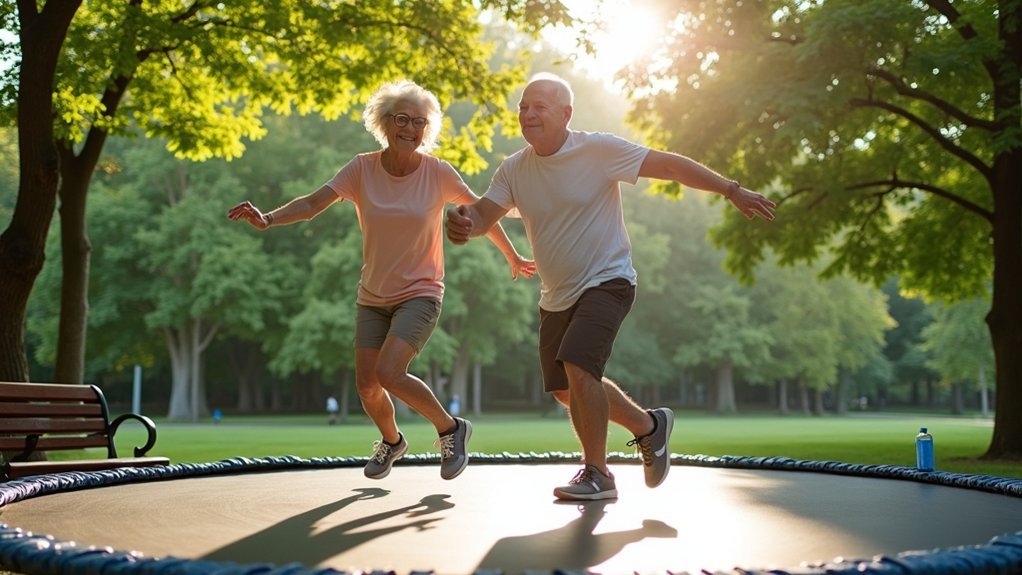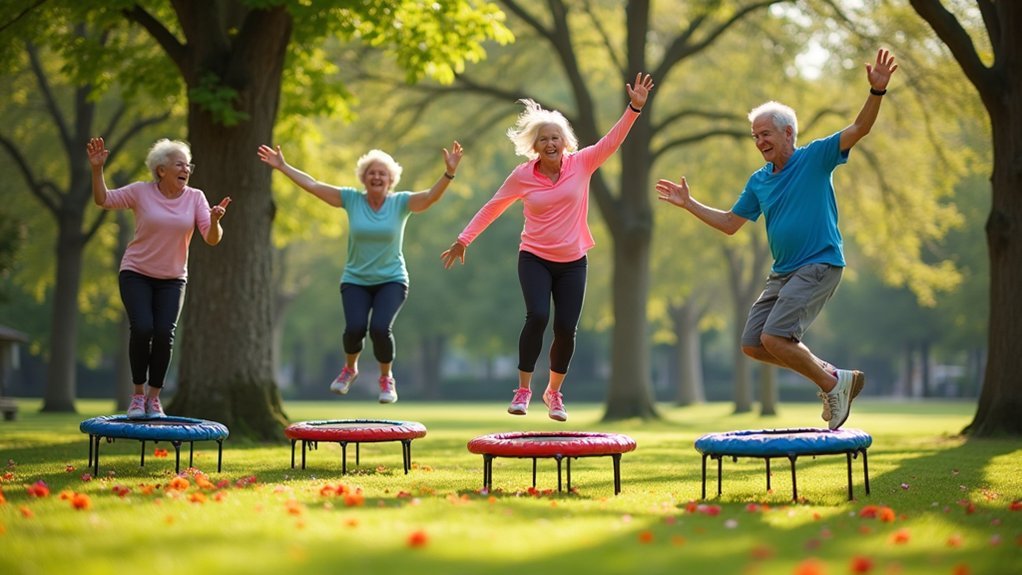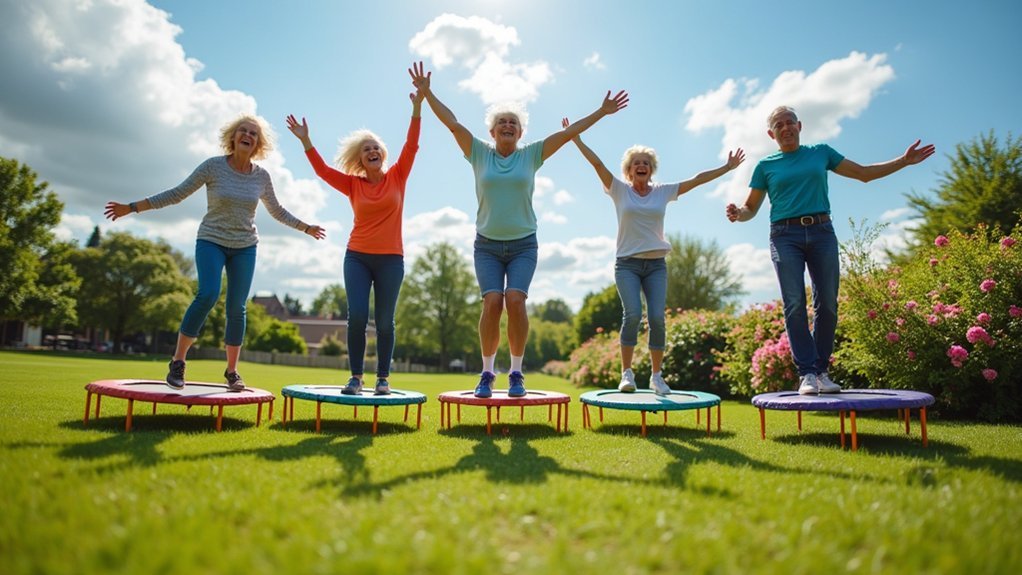Bouncing on a mini-trampoline offers remarkable health benefits for seniors. You’ll strengthen aging bones, combat muscle loss, improve heart health, and enhance balance—all with minimal joint impact. Regular rebounding increases bone mineral density, boosts circulation, and expands lung capacity while engaging multiple muscle groups. Just 5 minutes daily can revitalize your cardiovascular system and strengthen stabilizing muscles. Discover how this gentle, effective exercise can help maintain your independence and vigor as you age.
The Science Behind Bouncing for Bone Health

While many seniors focus on cardiovascular exercise, the impact of bouncing activities on bone health deserves special attention.
When you bounce, you create mechanical stress on your bones, stimulating bone growth and improving density. This weight-bearing exercise promotes bone remodeling—a process essential for maintaining bone health as you age.
Research shows that bouncing can considerably increase bone mineral density in your lumbar spine and hip area, particularly beneficial if you have osteopenia. A five-year OSU study found that participants performing 50 jumps three days a week experienced significantly less bone loss than the control group.
Studies confirm: bouncing significantly boosts bone density where you need it most—your spine and hips—especially if you’re facing early bone loss.
What makes this approach remarkable is its accessibility. You don’t need expensive equipment to reap the benefits.
The science is clear: consistent bouncing three times weekly can influence bone turnover markers and lead to long-term improvements in your skeletal strength, making it as effective as resistance training for preserving bone health.
Rebounding to Revitalize Aging Muscles
You’ll find that rebounding offers a powerful way to fight age-related muscle loss through its unique combination of low-impact, plyometric movements.
The bouncing motion builds explosive power in your muscles, which directly translates to improved balance and strength for everyday activities like climbing stairs or rising from chairs.
Regular trampoline exercise revitalizes aging muscle tissue, helping you maintain independence and confidence in your daily functions. Muscle mass typically declines at a rate of 3-5% per decade starting in your 30s, making rebounding an essential intervention for seniors.
Counteracting Age-Related Decline
As we age, our bodies naturally experience a decline in muscle mass and function, with sarcopenia causing a 3-5% decrease per decade starting in our 30s.
Rebounding offers a powerful way to combat this decline while protecting your joints.
The rhythmic bouncing motion:
- Engages multiple muscle groups simultaneously, helping slow muscle deterioration
- Improves balance and coordination by challenging your body’s stabilizing systems
- Enhances cardiovascular health through increased circulation and aerobic activity
- Stimulates bone density via gentle gravitational forces that strengthen skeletal structure
This low-impact exercise is particularly valuable as you age, as it provides extensive benefits without stressing arthritic joints or weakened muscles. TrampoLEAN’s rebounding sessions create increased G-force with each bounce, signaling your body to strengthen muscles and bones naturally.
You’ll experience improved mobility and strength that supports daily activities.
Building Explosive Power
Contrary to popular belief, seniors can build explosive power even in their later years through the unique benefits of rebounding.
When you bounce, your muscles undergo significant architectural changes with thickness increasing up to 5.8% alongside improved fascicle length and pennation angle. The stretch-shortening cycle during rebounding triggers rapid muscle remodeling, enhancing your power generation capabilities while being gentler on your joints than traditional exercises.
You’ll engage multiple muscle groups simultaneously, strengthening your legs, core, and back while improving overall muscle endurance. This low-impact activity is particularly beneficial if you have arthritis or joint concerns.
Research shows that trampoline-based plyometric training delivers functional power enhancements that specifically benefit older adults, helping you maintain independence and vitality.
Enhancing Daily Functions
While aging naturally impacts muscle function, rebounding offers a practical way to revitalize your declining muscle strength. The gentle bouncing motion strengthens your muscles without straining joints, helping you maintain independence and mobility.
- Improved stability – As you bounce, your core muscles engage to keep you balanced, enhancing proprioception and reducing fall risks.
- Enhanced circulation – The rhythmic movement stimulates blood flow and lymphatic drainage, reducing swelling in legs and feet.
- Better bone density – The low-impact stress on your skeletal system promotes bone strength without risking injury.
- Increased functional ability – Stronger muscles and better coordination directly translate to easier performance of daily tasks like climbing stairs, carrying groceries, and maintaining personal care. Studies show that rebounding can combine exercise with enjoyment, making workouts feel less strenuous while delivering moderate-to-intense cardiovascular benefits.
Heart and Lung Benefits of Gentle Bouncing
The gentle motion of bouncing offers remarkable benefits for seniors’ cardiovascular and respiratory systems. When you bounce regularly, your heart grows stronger and pumps blood more efficiently throughout your body. This activity helps manage blood pressure and maintain healthy cholesterol levels, greatly reducing your risk of heart disease.
Your lungs also reap substantial rewards. As you bounce, your respiratory function improves, increasing your lung capacity and oxygen intake. This enhanced oxygen flow energizes your body’s tissues, reducing fatigue and boosting your endurance for daily activities.
The improved circulation from gentle bouncing prevents blood from pooling in your legs while reducing inflammation throughout your body. The low-impact exercise is especially beneficial for seniors as it provides an effective cardiovascular workout without putting stress on joints and bones. These combined benefits create a powerful defense against chronic conditions while supporting your overall cardiovascular health.
Safe Rebounding Practices for Older Adults

You’ll want to start with low-intensity bounces and gradually increase your activity level as your confidence and strength improve.
Choosing a mini-trampoline with stability handles guarantees you’ve got proper support during your rebounding sessions.
Always position yourself near a wall or sturdy furniture for additional balance support, especially when you’re first learning rebounding techniques.
Maintaining a micro bend in knees while bouncing is essential for proper form and helps prevent joint strain during your rebounding workout.
Start Low, Progress Slow
Starting on a rebounding journey requires seniors to adopt a cautious approach that honors their bodies’ unique needs and limitations.
You’ll find rebounding more enjoyable and sustainable when you build your foundation carefully.
- Consult your doctor before beginning, especially if you have chronic conditions, to verify rebounding is appropriate for your health situation.
- Begin with simple movements like gentle bouncing for just 2-3 minutes, gradually working up to longer sessions as your strength improves. Remember that consistency is key, and increasing your rebounding time by one minute weekly will help you build endurance safely.
- Use handlebars or support initially to maintain balance and prevent falls while your body adapts to the unstable surface.
- Include proper warm-ups and cool-downs with each session, paying special attention to ankle and foot flexibility to prevent discomfort.
Proper Equipment Selection
Selecting proper equipment represents one of the most critical safety factors for seniors initiating a rebounding journey.
Look for rebounders with safety pads covering springs and sturdy handlebars that provide essential balance support.
Choose between spring or bungee cord models based on your needs—springs offer firmer bounces while bungee cords provide gentler, quieter workouts and often allow for tension adjustment.
If space is limited, consider foldable designs for easy storage.
Don’t overlook weight capacity ratings and verify your rebounder has anti-slip feet for stability during use.
Padded, comfortable handles will reduce strain on your hands during longer sessions.
Experts recommend choosing a rebounder with a high-quality steel frame to ensure maximum safety and longevity during your rebounding exercises.
Remember that proper equipment not only enhances safety but also improves your exercise experience, making it more likely you’ll maintain this beneficial activity.
Balance Support Techniques
Balance support techniques represent the cornerstone of safe rebounding for seniors.
You’ll build confidence on your rebounder through progressive training that markedly reduces fall risk. Studies show 12-week programs produce measurable improvements in balance for older adults with low bone mass. Rebounding exercises have shown to provide a 35% improvement in balance capability for seniors when practiced regularly.
- Start with stability aids – Use a handlebar with a light touch grip for emergency support, not weight-bearing dependence.
- Practice controlled landings – Train your body to respond to “mini-falls” through gentle bounces that strengthen neuromuscular reactions.
- Use proper breath control – Exhale during landing phases to engage your core for better stabilization.
- Incorporate multiplane movements – Challenge your balance system holistically with side-to-side shifts and diagonal reaches.
How Daily Bouncing Enhances Mobility and Independence

For seniors seeking to maintain their lifestyle, daily bouncing has emerged as a surprisingly effective approach to improving mobility and independence.
You’ll notice significant improvements in walking speed and gait performance after incorporating regular rebound exercises into your routine. These bouncing activities strengthen muscles essential for daily activities while reducing your risk of falls.
Daily bouncing exercises significantly improve mobility, strengthen essential muscles, and reduce fall risk for seniors seeking independence.
The cardiovascular benefits enhance your overall fitness, and improved muscle coordination directly supports your mobility. Research shows that aiming for two sessions weekly of moderate-intensity exercise can significantly improve walking speed and delay mobility disability in older adults. You’ll likely experience reduced fear of falling, which boosts confidence in moving independently.
What’s particularly valuable is that the benefits are often sustained long-term, especially when practiced in group settings.
While responses vary based on individual health conditions, even those with neurological challenges like Parkinson’s or stroke recovery can achieve meaningful improvements.
Choosing the Right Rebounder for Senior Fitness
Choosing the right rebounder represents a critical decision for seniors starting on a bouncing exercise routine.
You’ll want to prioritize safety features like sturdy handrails and non-slip surfaces while ensuring the rebounder can support your weight with a wide, stable base.
Look for models with proper impact absorption technology—bungee cord suspensions offer superior joint protection compared to metal springs.
Consider your budget alongside durability needs; mid-range options ($150-300) typically provide the best balance of quality and affordability for seniors.
- Verify safety features: handrails, weight capacity, and enclosed springs
- Select models with joint-friendly bungee suspension when possible
- Consider storage needs—foldable designs work well for limited spaces
- Check for certifications and warranties that reflect quality construction
Models like JumpSport are preferred for their arched legs design which provides exceptional stability and prevents wobbling during exercise, a crucial safety factor for older adults.
Beginner Rebounding Routines for Ages 65+
Starting a rebounding routine after age 65 doesn’t require intense workouts to deliver meaningful health benefits. Begin with 5-minute sessions of basic bouncing to acclimate your body to the trampoline’s motion.
As you build confidence, incorporate gentle heel-to-toe taps to improve your balance. Try small jumps combined with arm raises to enhance coordination and upper body strength. Modified jumping jacks can boost your cardiovascular health without straining joints. The health bounce is an excellent foundational movement that helps develop proper rebounding form.
Remember to maintain proper posture throughout each exercise and use handrails if needed. Schedule regular sessions and gradually increase duration as your stamina improves. Track your progress to stay motivated.
Always listen to your body and stop if you experience discomfort.
These low-impact exercises will strengthen your core muscles, enhance circulation, and support your lymphatic system—all while being gentle on aging joints.
Frequently Asked Questions
Can Rebounding Help With Cognitive Decline or Memory Issues?
Yes, rebounding can help with cognitive decline or memory issues. You’ll notice enhanced attention, processing speed, and cognitive flexibility. It improves blood flow to your brain and stimulates neuroplasticity, supporting cognitive resilience with consistent practice.
How Does Bouncing Affect Balance-Related Inner Ear Conditions?
Bouncing can indirectly help your balance-related inner ear conditions by improving proprioception and stability. While it won’t cure vertigo or BPPV directly, you’ll develop better overall balance that may reduce symptoms over time.
Will Rebounding Worsen Arthritis or Joint Pain?
No, rebounding won’t typically worsen arthritis or joint pain. You’ll benefit from its low-impact nature, which absorbs 80% of impact forces and stimulates synovial fluid production that can actually ease joint stiffness.
Can Rebounding Benefit Seniors With Chronic Health Conditions?
Yes, rebounding can benefit you if you have chronic conditions. It’s gentle on joints, improves circulation, strengthens bones, enhances balance, and can help manage arthritis, heart issues, and digestive problems safely.
How Does Rebounding Compare to Swimming for Joint-Friendly Exercise?
Both rebounding and swimming offer joint-friendly benefits. You’ll find rebounding more convenient at home, while swimming engages more muscle groups. They’re equally effective for reducing fall risk and improving cardiovascular health.
In Summary
You’ve now discovered why gentle rebounding deserves a place in your daily routine. By bouncing just minutes each day, you’re strengthening bones, revitalizing muscles, and boosting cardiovascular health without stressing your joints. Start with supported, low-impact bounces and you’ll soon notice improved balance, mobility, and energy. It’s never too late to experience the transformative benefits of this accessible, enjoyable exercise that helps maintain your independence.





Leave a Reply